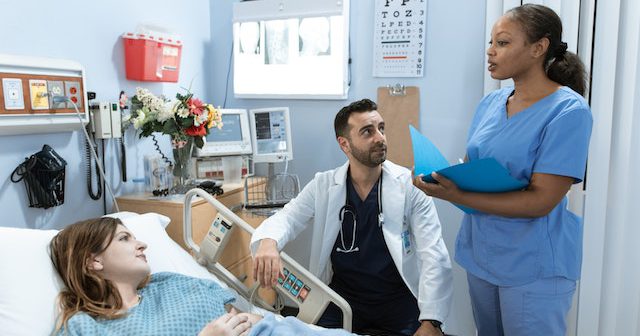Today, the healthcare industry concentrates more on patient-centered care, enabling patients to manage their well-being and improving their satisfaction with better services. Patients who know about their health and treatment options have a better ability to make decisions and work towards preventing or minimizing disease complications.
Patient education plays a role in health outcomes. It was once a doctor’s or a physician’s job, but today nurses are also responsible for helping patients be aware of their health condition and make informed choices about it. Patient education includes details about health disorders, treatments, and navigating the healthcare system. The objective of educating patients is to inspire them to take charge of their health.
A nurse is often the first healthcare provider who patients meet. Their one-on-one, direct contact with patients, puts them in a position to build respect and trust.
Nurses must educate the patient in a way that is easy to understand. From teaching a new mom the tips for newborn care to guiding senior individuals suffering from a chronic illness, educating patients is an essential part of nursing care.
Here are some ways nurses can contribute to patient education.
- Prepare Yourself
The first step to promoting patient education is getting yourself prepared. Nurses need to improve patient education constantly. But how? To accomplish this, you may be required to equip yourself with the necessary skills. The higher qualified nurses are, the better their skills to enhance patient education
Nurses with a BSN and wanting to pursue a higher education degree online might want to consider some affordable FNP programs by La Salle university to advance their education and develop vital skills to improve patient care.
Acquiring higher education will help you practice independently and with a team while delivering patient care services in different healthcare systems.
- Keep Things as Simple as Possible
A significant problem in patient-centered care is communication between the healthcare provider and patient throughout the process. If patients cannot understand their diagnosis, recommended medical examinations and treatments, and follow-up instructions, they will not be able to participate in their care.
Poor health literacy is one of the common barriers to effective care. Studies suggest that only a limited number of individuals have health literacy skills, and most people experience hurdles using the health information commonly available in healthcare facilities.
Cerebral embolism, benign cancer, myocardial infarction, acute bronchitis, CBC, and dorsiflexion may all be common terms for healthcare professionals, including nurses. However, patients may be unable to understand these. Avoiding the use of medical abbreviations and terminologies and keeping it simple can help nurses educate their patients easily and a bit more quickly.
- Answer Every Query
As a nurse, you must be able to cater to patient queries to clear their uncertainties and improve education. Some patients might even ask for little things or details, and that is normal. Remember, this can even happen repeatedly.
Although some of the queries can only be answered by doctors, nurses must stay calm and prepared for the following common questions.
- What is the purpose of this procedure or medication?
- What are the alternatives to the specific treatment?
- How many times has the doctor provided treatment?
- When can I get back to work?
- How many times will the doctor perform a particular procedure?
- Are there any side effects of the medication/treatment?
Make Use of Technology
The role of technology in nursing has grown significantly and made patient education more accessible. Several educational resources available can be customized for patients’ individualized needs. These resources are available in various languages to help patients with different native languages understand the information.
Technology is vital in modern healthcare. The adoption of some technological advancements, such as telehealth, has revolutionized the field. Telehealth nursing refers to the use of digital communication and information technology, like smart devices or personal computers, to provide nursing services remotely.
- Involve Family Members in Patient Education
Family involvement is a crucial element of patient-centered care that affects patient outcomes. Including a trusted family member in patient teaching increases the chances that guidelines will be followed. They can help ensure the patient is eating well, taking medications on time, and engaging in physical activity as required. Family involvement in cases such as acute care can help nursing professionals in an emergency.
- Try to communicate in the patient’s language
Effective communication between healthcare providers and patients is vital to delivering optimal health care. Research suggests that language concordance between the provider and the patient leads to better care quality and patient education. Language concordance can occur when nurses are fluent in the languages their patients understand.
However, hurdles can occur when the two parties do not speak a similar language. As a nurse, you should not assume that every patient can speak and understand English or your native language, nor should you depend on the patient’s family to interpret your teachings. Instead, employing an expert interpreter can be helpful for both parties.
- Write Down Detailed Instructions
When your patient is sick, struggling with mobility, breathing, pain, or nausea, they may experience hurdles in remembering detailed information or learning concepts. Nurses can write down important information and guidelines for patients to refer to after they get discharged from the hospital.
- Educate Patients in Various Forms
Every patient may have a different learning style. Nurses need to determine it and provide education in a way their patient best absorbs it. These learning styles may include
- Visual learning
If the patient is a visual learner, they absorb information by observing and seeing. They can learn best with flow charts, diagrams, and pictures.
- Tactile learning
Tactile, also called kinaesthetic learners, need to physically experience (touch) or try something to learn.
- Auditory learning
A patient with an auditory learning style retains more information from listening than from written details.
- Reading and writing learning style
It can be referred to as a type of visual learning. These patients will prefer to read and write to understand concepts better. Writing down detailed information and instructions can be a great way to help them.
Conclusion
Patient education is essential for increasing the patient’s knowledge and understanding while preparing them for self-management. The goal is to enhance patient health outcomes and the quality of life. Health care providers, especially nurses, are responsible for educating patients in various ways. These may include using advanced technology, identifying patients’ learning styles, answering patient concerns, effective communication, and writing down details. The goal is ensuring patients understand the medical procedures and how to care for themselves.





Solution2Pass additionally offers Salesforce PDI practice test programming for work areas. It fills in as a helpful device for trying what you’ve realized. Besides, the work area Salesforce PDI programming permits you to evaluate your status for the Salesforce Platform Developer I test. The work area Salesforce Platform Developer I Certification design accompanies its own establishment setup, making reading up for the Salesforce PDI test simpler. Setting up on a Windows computer is basic.
Thank you for your post, myself very happy to read it because it can give me more insight, thanks. how to increase milk supply
The medical students are given essay assignments to bring out new facts and information related to improving nursing. The nursing assignment demands solid work, thorough investigation, active contribution, and deep capability and tenacity to explore and write the project in a progressive way. https://www.essaymills.co.uk/nursing-essay-service
Nurses can do a lot to improve patient education. The number of nurses in the United States has increased by more than 20% since 2000, according to the Bureau of Labor Statistics. I would recommend roofing company westminster for best companies for roofing. As nurses are becoming more prevalent, they are also expected to be better educated and more aware of their role as patient educators. Nurses can also help patients navigate through complex medical conditions and procedures.
Nurses can contribute to improving patient education in many ways. Nurses are the first line of defense when it comes to patient education. Nurses are the ones who take care of patients at hospitals and clinics, so they have a unique perspective on what patients need to know. Try this digital marketing company yuma for more ideas. Nurses are also trained to listen to patients and understand their needs, which is crucial when it comes to educating patients about their medical conditions and treatments.
Nurses are often in a unique position to provide patients with the information they need to make informed decisions about their care. Nurses can help patients understand the importance of home care and other self-management strategies by providing homework assignments and encouraging them to complete them. Go to marble suppliers for best ideas. Nurses should educate patients about the medications they take, including dosages and side effects, so that they know when it’s time for a refill or substitution. Nurses should also let patients know if there are any changes in dosage required based on health conditions or lifestyle changes.
Valid4sure is a well-known brand that offers updated material in the form of HP Selling HP Workstations 2022 HP2-I44 dumps PDF, desktop exam simulation software, and a web-based HP Sales Certified HP2-I44 Practice Test.
Dentists are medical professionals who work with patients to help maintain a healthy mouth, teeth and gums. Dentists are trained to diagnose dental issues and recommend the best treatment for each patient. The dentist 85257 typically have a four-year undergraduate degree before applying to dental school. After graduating, they must complete a dental degree program that can take up to five years to complete.